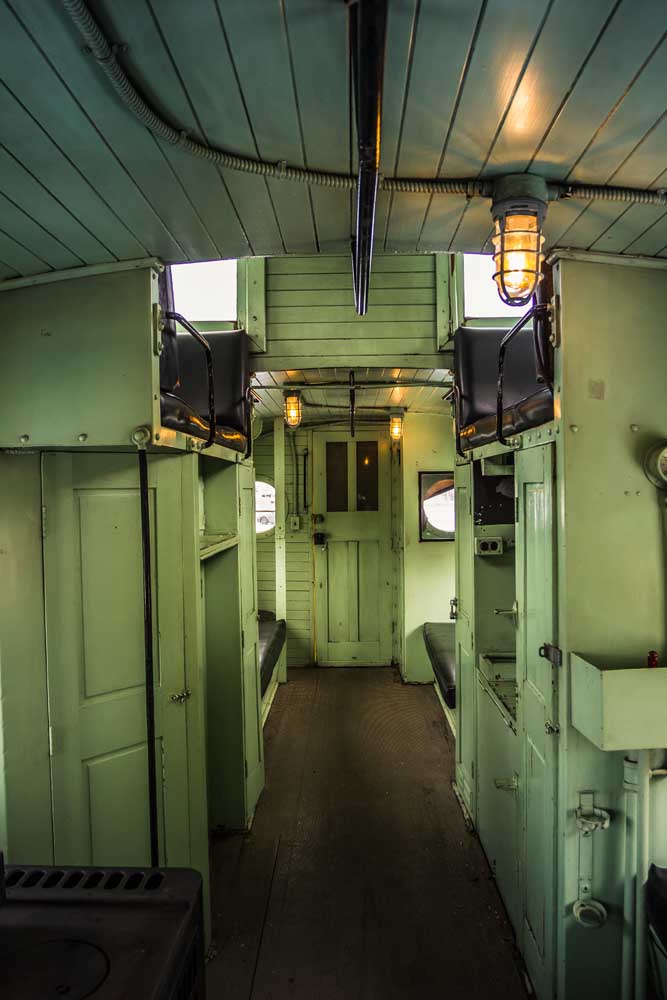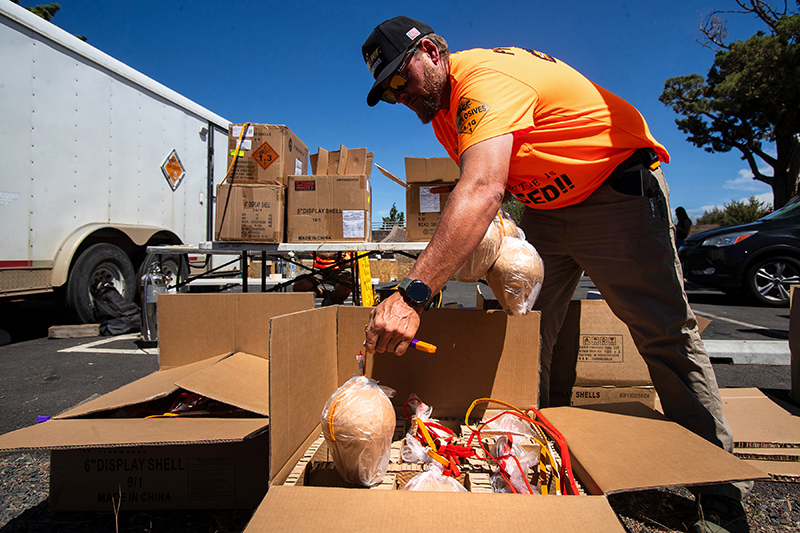Day trip: Keeping history alive in Prineville
Published 12:00 am Sunday, February 24, 2019

- The interior of the 1945 caboose from the Prineville Railway on display at the A.R. Bowman Museum. (Makenzie Whittle/The Bulletin)
The Tastee Treet in Prineville was full of locals filling up on pancakes, scrambles and bottomless coffee on a recent cold Saturday morning.
“We come here every Saturday,” one woman told her waitress as she paid for her breakfast. “Last week we came Saturday and Sunday.”
The small diner has been serving hot-from-the-griddle breakfasts and burgers and decadent shakes since 1957. It’s a local favorite. The diner is split into two sections with separate entrances.
“You’ll have to go all the way ‘round,” an older gentleman said with a smile sitting at the counter reminding one diner as they tried to get to find a table, “Sorry!”
His apology seemed genuine, something you’d expect from a small town eatery. He promptly went back to his conversation with his friends at the counter about the local news of the day.
The scene at the diner was friendly, familiar and void of pretense; the slice of Americana at Tastee Treet is everywhere you go in Prineville.
A rich history
Prineville is a small town that prides itself on keeping history alive.
Peter Skene Ogden led a trapping expedition through the area in 1824-25. The trappers, who were in search of mostly beaver pelts, were the first known Europeans to travel through Central Oregon.
Slowly, settlers began making their way west and established roots in the area, finding suitable land for farming and grazing using the flow of the nearby Ochoco Creek and Crooked River for irrigation.
In 1877, a town was platted by Elisha Barnes and was named after the area’s first merchant, Barney Prine. Thus, the oldest city in Central Oregon, Prineville, was born.
The county seat of Crook County, Prineville was the hub of Central Oregon life. The entire county encompassed more than 8,600-square miles. But it shrunk to just under 3,000-square miles with the establishment of Jefferson County in 1914 and then Deschutes County in 1916.
Before the counties split, Prineville settlers felt certain that because of its status in the county, the Union Pacific Railroad would see fit to bring the inevitable railroad through the town. They guessed wrong.
In 1910, the Union Pacific Railroad company chose the fledgling cities of Bend and Redmond to steam through, leaving Prineville to seemingly suffer the same fate that many towns had at the hands of being overlooked by the mighty train company.
Prineville had other plans.
Rather than be left in the dust by progress, the city banded together in 1918 and formed its own municipal railroad that would stretch from the west side of the city 19 miles to meet the Union Pacific just north of Redmond. The gamble paid off and the city remained, though never quite reaching the heights of Bend. Prineville survived and still operates the only city-owned railway in the United States.
Today, the road into town from the west is met with the signs of changing times for Prineville. Massive data centers from Facebook and Apple have taken the place of the juniper dotted landscape.
Soon after the monolithic buildings, the landscape opens to the valley below, nestled between basalt mesas and buttes.
As the road descends towards the town of just over 10,000 people, the Ochoco Wayside offers travelers a spectacular view of the city below.
Further east along U.S. Highway 126, the main thoroughfare is lined with local shops and boutiques interspersed with national fast food chains, banks and real estate offices. Halfway through town one facade catches the eye.
A turn of the century, brick building adorned with a clock tower and cupola, vines crawling up the sides and a fountain that’s front and center.
The Crook County Courthouse was built in 1909 on the site of the previous and first courthouse in the county.
In fact, it was the Taj Mahal of courthouses in Central Oregon that created a rift between Prineville and the outlying communities such as Bend, Redmond and Madras. The concern was that the new and improved building would increase the outlaying area’s taxes, thus actions were initiated to form Jefferson and Deschutes counties.
Backtracking down Third Street (the main thoroughfare through Prineville) in the former Crook Country Bank building is the A.R. Bowman Museum.
Full of the rich history of the area, the museum preserved the original marble bank counter and teller windows with bars as well as the original hanging lights. Visitors can walk into the original bank vault while perusing the stacks of artifacts held behind glass.
Items donated by local families and collected by museum curators hold stories of the town’s vibrant and sometimes violent past.
Information on the tensions between the cattle and sheep ranchers in the 1890s and early 1900s, known as the Sheep and Cattle Wars that spread across many western states, and on the murder of a two local men by Lucius Langdon. He inspired a group of vigilantes to form a Committee of Vigilance and the group in turn sought out where Langdon was being held awaiting trial and murdered him. The museum includes the gun that Langdon used to shoot the men.
For a less bloody view of the area’s history, the museum is full of interesting stories from the city’s 142-year history. Stories of Les Schwab’s humble beginnings to operating his tire empire, information on the importance of Prineville lumber mills and the ponderosa pines that kept them running, and on the Northern Paiute tribes that inhabited the area before being relocated to Warm Springs and the Burns Paiute reservations.
The museum’s second-story floor holds a furnished 19th century parlor, a tack shop and a medical office full of information about the Rocky Mountain spotted fever outbreak at the turn of the 20th century and smallpox in 1903, doctors, hospitals and various medical techniques. Devices used to cure ailments are also on display, including a vacuum-like device to aid a patient with tuberculosis.
Outside in a small courtyard is a bright yellow rail car with Prineville Railway painted in bold letters on either side. Donated by the railway in 2017, the caboose was recently restored to its original luster. The 1945 car offers visitors the chance to literally take a walk through the history of the community.
A small stove sits to the left of the entrance of the mint-green walled caboose and two upper level seats are located in a cupola-like structure in the middle of the car. Riders of the car would have had to clamor up the small foot holds in order to reach the seats, but with panoramic windows, the climb would have been worth it.
The courtyard also features a replica of the original facade from the railway, returning visitors to the time when this grand idea helped save the community.
The tale of two breweries (and a distillery)
Central Oregonians love beer. Towns are dotted with brewmasters creating special concoctions to sell in the breweries that employ them. Prineville has two breweries.
One brewery currently offers two varieties of cider, but it is working toward expanding to include beer.
Crooked River Brewing has plans to start pumping out its own beers come late March or early April, but for now, its location in the heart of Prineville offers taps with other local brews, food and its Pint Sized Theater. The theatre shows newer releases and hosts occasional Fortnite tournaments for players of all ages.
A short walk away is Ochoco Brewing.
Opening in 2011 as Solstice Brewing, its name changed in 2015 to Ochoco.
The name pays homage to the first brewery in Central Oregon, which ran from 1882-90, according to local beer historian and Bulletin contributor Jon Abernathy.
The brewery’s tap list includes over 20 of its own concoctions, some named after local landmarks — Double Dam IPA and Steins Pillar — or to reclaim references like Prinetucky, a term coined by those living outside the small town.
One block northwest of the brewery is a Foundry Four Coffee + Whiskey. It opened in August brewing cups from Sisters Coffee Co. beans. As of Feb. 15, the business is selling its own rye whiskey.
Foundry Four is located in a 1929 building. The owners have made every effort to retain the 90-year patina and keep the history it has seen alive. The flaking yellow-brown concrete walls show the building’s age. There are holes in the old wooden door that separates the coffee bar from the distilling room and a large, slightly rusted gear hangs above the bar.
The great outdoors
Prineville has been a go-to place for many Central Oregonians outdoor pursuits with ample hiking trails in the Ochoco Mountains, fishing holes dotting the Crooked River and summer boating in reservoirs.
The Crooked River winds through Prineville and to the Prineville Reservoir. Its sheer and steep walls make bank fishing difficult, but the large lake is a popular destination for riding Jet Skis in the summer.
Ochoco Reservoir in Prineville was the first reservoir created. It was used to bring water to area farmers and ranchers shortly after World War I, but the dam had persistent leaks and was deemed hazardous. So, a second dam was built creating Prineville Reservoir. Ochoco has gentle banks for fishing year-round if you can brave the frigid winds of the colder months that will often howl over the lake.
The Ochoco National Forest area is full of hiking trails, though not all the trailheads are well marked.
One trail leads to one of the forest’s most prominent features: Steins Pillar (pronounced Steens), a 300-foot tall rock protruding from the hillside that was formed during a volcanic event 29.5 million years ago.
A 3.8-mile trail to the rock ends at its base, where the sheer height of the rock pillar can be appreciated.
Keeping their roots
“Forever country” is the phrase the Prineville Chamber of Commerce states on its website.
This country life idea permeates through the nooks and crannies of the city and the Ochoco National Forest that neighbors it.
Though the city and county are among the fastest growing in the state, and you can see changes happening, Prineville still proudly holds on to that motto and its history.
In the summer, the Crooked River Roundup boasts that it’s one of the oldest rodeos in the state, complete with the stampede through town where cows are herded down Third and Main streets (think cattle drive) and three days of horse races.
With new cafes, shops and restaurants opening, Prineville holds fast to its Central Oregon history and small-town charm.
— Makenzie Whittle is a Bend native. She and her family have taken day trips since she was an infant, exploring the far reaching corners of Oregon, learning about history, geology and the communities that make up the state. She continues the tradition today, and can be reached at 541-383-0304 or mwhittle@bendbulletin.com








